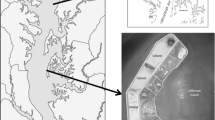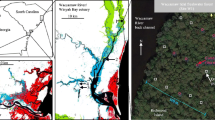Abstract.
Twenty-eight tidal creeks were sampled along the South Carolina coast in the summer of 1995 to determine the levels of sediment trace metal contamination associated with different types and varying levels of human development in their watersheds. The particle size and total organic carbon (TOC) content of creek sediments in developed watersheds (i.e., industrial, urban, and suburban) were similar to that in watersheds with little or no development (i.e., forested or reference). Those trace metals commonly associated with urban and industrial sources, including Cu, Cr, Pb, Zn, Cd, and Hg, were in significantly higher concentrations in tidal creeks located in industrial/urban watersheds compared to the suburban and forested watersheds. Sediment trace metal concentrations were similar for creeks located in suburban and forested watersheds and 2 to 10 times lower than the creeks located in industrial/urban watersheds. Concentrations of trace metals primarily associated with the natural weathering of basement rock, including Al, Fe, As, Ni, and Mn, were not significantly different among watershed types. Four of the tidal creek–salt marsh systems were extensively sampled from the creek channel to the marsh-upland interface to characterize sediment trace metal spatial distributions within creek-marsh systems. Sediment particle size, TOC, and trace metal concentrations varied spatially within each creek-marsh system depending on the type of development in the watershed and the probable source of metals. The creek-marsh system selected to represent the industrial development had significantly higher “anthropogenic” trace metal concentrations compared to the other creek-marsh systems. This system also had trace metal distributional patterns that appeared to be associated with several localized sources of metals on the marsh surface. Both the “anthropogenic” and “natural” trace metal concentrations andspatial distributions were similar among and within the forested and suburban creek-marsh systems.
Similar content being viewed by others
Author information
Authors and Affiliations
Additional information
Received: 8 December 1998/Accepted: 1 April 1999
Rights and permissions
About this article
Cite this article
Sanger, D., Holland, A. & Scott, G. Tidal Creek and Salt Marsh Sediments in South Carolina Coastal Estuaries: I. Distribution of Trace Metals. Arch. Environ. Contam. Toxicol. 37, 445–457 (1999). https://doi.org/10.1007/s002449900539
Issue Date:
DOI: https://doi.org/10.1007/s002449900539




